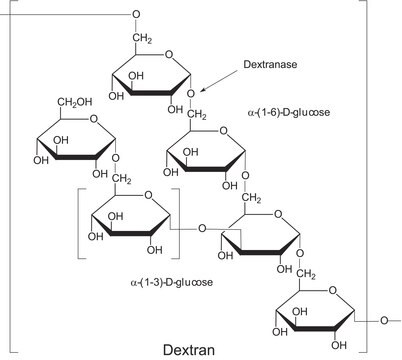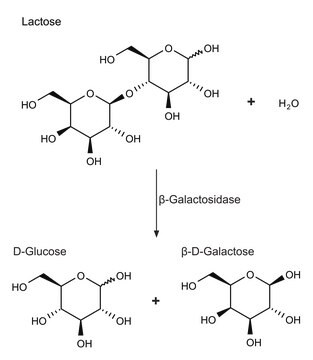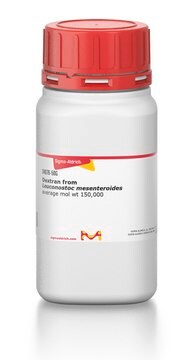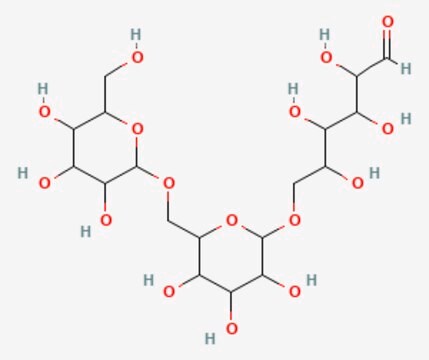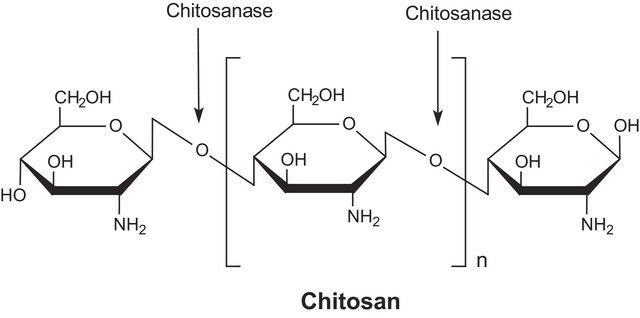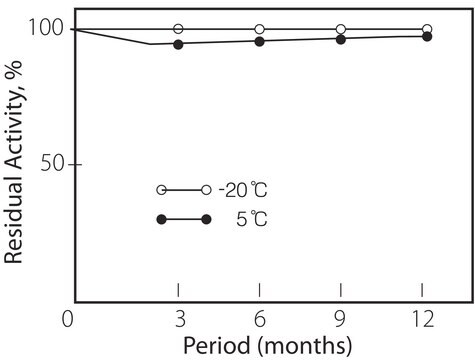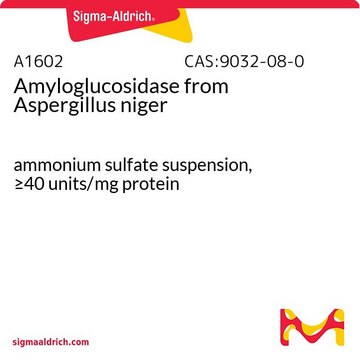D0443
Dextranase from Chaetomium erraticum
Sinonimo/i:
Dextranase Plus L, 1,6-α-D-Glucan 6-glucanohydrolase
Autenticatiper visualizzare i prezzi riservati alla tua organizzazione & contrattuali
About This Item
Prodotti consigliati
Stato
solution
Temperatura di conservazione
2-8°C
Descrizione generale
A product of Novozymes Corp.
Dextranase is generated by many microorganisms, including bacteria, filamentous fungi, and yeast.
Applicazioni
Dextranase from Chaetomium erraticum has been used:
- in microcarrier dissolution to produce multicellular 3D spheroids for drug discovery
- in in vitro digestion of extracellular polysaccharide (EPS) from the bacterial isolates
- in a study to investigate the immobilization of dextranase
- to investigate the optimization of process conditions for enzymatic modification of alternan
Azioni biochim/fisiol
Dextranase is an endodextranase that hydrolyzes α-(1,6)-glycosidic linkages in dextran. It has many industrial and clinical applications such as food processing, sugar modification, and medicine preparation. Dextranase is widely used to produce alternated sugar beet and isomaltooligosaccharides (IMOs), a prebiotic functional food. The low molecular weight dextran obtained from dextranase serves as a synthetic blood volume expander. Dextranase can be coupled to antibodies for the detection of tumor cells. It prevents the occurrence of dental plaques by depolymerizing microbial dextran deposits in teeth. Hence, it is used in dental care products.
Nota sulla preparazione
A fungal dextranase produced by submerged fermentation of Chaetomium erraticum.
Risultati analitici
Stable in the pH range of 3-7 and at temperatures up to approx. 70 °C. For most applications, the preferred conditions are pH 5-6 and a temperature of 50-60 °C.
Altre note
View more information on enzymes for complex carbohydrate analysis at www.sigma-aldrich.com/enzymeexplorer
Avvertenze
Danger
Indicazioni di pericolo
Consigli di prudenza
Classi di pericolo
Resp. Sens. 1
Codice della classe di stoccaggio
11 - Combustible Solids
Classe di pericolosità dell'acqua (WGK)
WGK 1
Punto d’infiammabilità (°F)
Not applicable
Punto d’infiammabilità (°C)
Not applicable
Dispositivi di protezione individuale
Eyeshields, Gloves, type N95 (US)
Scegli una delle versioni più recenti:
Possiedi già questo prodotto?
I documenti relativi ai prodotti acquistati recentemente sono disponibili nell’Archivio dei documenti.
I clienti hanno visto anche
Frank Alwin Erhardt et al.
Journal of biotechnology, 131(4), 440-447 (2007-09-19)
In order to facilitate the Co-Immobilization of dextransucrase and dextranase, various techniques for the immobilization of industrial endo-dextranase from Chaetomium erraticum (Novozymes A/S) were researched. Adsorption isotherms at various pH-values have been determined for bentonite (Montmorillonite), hydroxyapatite and Streamline DEAE.
F Abeille et al.
Lab on a chip, 14(18), 3510-3518 (2014-07-12)
Microfluidic bioreactors are expected to impact cell therapy and biopharmaceutical production due to their ability to control cellular microenvironments. This work presents a novel approach for continuous cell culture in a microfluidic system. Microcarriers (i.e., microbeads) are used as growth
Co-immobilization of dextransucrase and dextranase in epoxy-agarose-tailoring oligosaccharides synthesis
da Silva R, et al.
Process Biochemistry (Oxford, United Kingdom), 78, 71-81 (2019)
Young-Min Kim et al.
Applied microbiology and biotechnology, 91(2), 329-339 (2011-04-12)
Multiple forms of native and recombinant endo-dextranases (Dexs) of the glycoside hydrolase family (GH) 66 exist. The GH 66 Dex gene from Streptococcus mutans ATCC 25175 (SmDex) was expressed in Escherichia coli. The recombinant full-size (95.4 kDa) SmDex protein was digested
Mohanad Bashari et al.
Ultrasonics sonochemistry, 20(1), 155-161 (2012-07-24)
In our current research work, the effect of ultrasound irradiation on the enzymatic activity and enzymatic hydrolysis kinetic parameters of dextran catalysis by dextranase were investigated. Furthermore, the effects of ultrasound irradiation on the structure of dextranase were investigated with
Il team dei nostri ricercatori vanta grande esperienza in tutte le aree della ricerca quali Life Science, scienza dei materiali, sintesi chimica, cromatografia, discipline analitiche, ecc..
Contatta l'Assistenza Tecnica.

